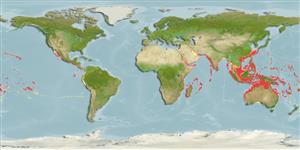Common names from other countries
>
Anguilliformes (Eels and morays) >
Ophichthidae (Snake eels) > Ophichthinae
Etymology: Myrichthys: Greek, myros, -ou = male of morey eel + Greek, ichthys = fish (Ref. 45335).
More on author: Cuvier.
Environment: milieu / climate zone / depth range / distribution range
Ecologia
marinhas associadas(os) a recifes; intervalo de profundidade 0 - 262 m (Ref. 9710). Tropical; 30°N - 33°S
Indo-Pacific: Red Sea and East Africa to the central Pacific, not including Hawaii and the Leeward Islands. Replaced by Myrichthys magnificus in the Hawaiian Islands (Ref. 26145, 37816).
Tamanho / Peso / Idade
Maturity: Lm ? range ? - ? cm
Max length : 100.0 cm TL macho/indeterminado; (Ref. 1602); common length : 50.0 cm TL macho/indeterminado; (Ref. 9137)
Descrição breve
Chaves de identificação | Morfologia | Morfometria
Espinhos dorsais (total) : 0; Raios dorsais moles (total) : 0; Espinhos anais: 0; Raios anais moles: 0; Vértebras: 185 - 189. Pale cream in color with variable pattern of large and small black spots with narrower white interspaces (Ref. 3972, 48635). Young with black saddles (Ref. 3972). Its behavior is similar to Myrichthys colubrinus and Leiuranus semicinctus.
Found in sandy areas of reef flats, lagoons, and seaward reefs; living buried in the sand. May aggregate in large numbers under a light at night (Ref. 9710). Sometimes fully exposed when searching for prey (Ref. 30874). Feeds on small fishes and crustaceans (Ref. 89972). Solitary and more common at night (Ref 90102).
Life cycle and mating behavior
Maturities | Reprodução | Spawnings | Egg(s) | Fecundities | Larvas
McCosker, J.E. and R.H. Rosenblatt, 1993. A revision of the snake eel genus Myrichthys (Anguilliformes: Ophichthidae) with the description of a new eastern Pacific species. Proc. Calif. Acad. Sci. 48(8):153-169. (Ref. 40867)
Categoria na Lista Vermelha da IUCN (Ref. 130435)
CITES (Ref. 128078)
Not Evaluated
Ameaça para o homem
Harmless
Utilização humana
Pescarias: espécies comerciais; Aquário: Espécies comerciais
Ferramentas
Relatórios especiais
Descarregue XML
Fontes da internet
Estimates based on models
Preferred temperature (Ref.
115969): 19.2 - 28.2, mean 26.1 (based on 991 cells).
Phylogenetic diversity index (Ref.
82804): PD
50 = 0.5005 [Uniqueness, from 0.5 = low to 2.0 = high].
Bayesian length-weight: a=0.00089 (0.00039 - 0.00204), b=3.00 (2.80 - 3.20), in cm Total Length, based on LWR estimates for this (Sub)family-body shape (Ref.
93245).
Nível Trófico (Ref.
69278): 3.6 ±0.5 se; based on size and trophs of closest relatives
Resiliência (Ref.
120179): Médio, tempo mínimo de duplicação da população 1,4 - 4,4 anos (Preliminary K or Fecundity.).
Fishing Vulnerability (Ref.
59153): High vulnerability (60 of 100).
